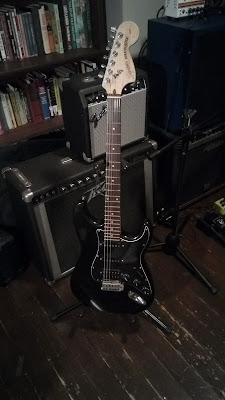Just recently I had to fix a strat where the wood was badly cracked around the two mounting posts for the bridge. The wood was practically busted out, causing the posts to lean sharply forward. It was pretty bad structural damage, but it was actually fairly easy to fix.
 |
| One set of the cracks with the post removed. (I forgot to take "before" pictures, so this is while I was working.) |
- First, I drilled out the entire damaged area with a Forstner bit. Before drilling, I centered the bit on the hole by replacing the mounting post and lowering the drill bit down until the point was centered on the top of the post. Then I clamped the body to the drill press, removed the post, and drilled.
After that, I plugged the hole I had just drilled with a piece of a hardwood dowel rod. I glued it in very firmly with Titebond II wood glue and then left it clamped for 24 hours. I didn't drill out the second mounting post hole yet because the drill might have torn out the piece of wood left in the middle.
Once the first plug had dried solid, I drilled and plugged the hole for the second post the same way.
When both plugs had been tightly glued in and dried for at least 24 hrs, I drilled new holes for the bridge mounting posts. Because I centered the bit on the original holes back in Step One, all I had to do now was drill in the center of each plug, and the new holes would be in the same spot.
With that done, I carved the plugs down with a chisel to match the original shape of the wood ( accidentally slicing a fingertip in the process), and tapped the posts in their new holes with a rubber mallet.
Finally, I painted the plugs black (probably should have done that before reinstalling the posts), reassembled the guitar, and gave it a good setup. When I finished, the guitar was as good as new.






Comments
Post a Comment